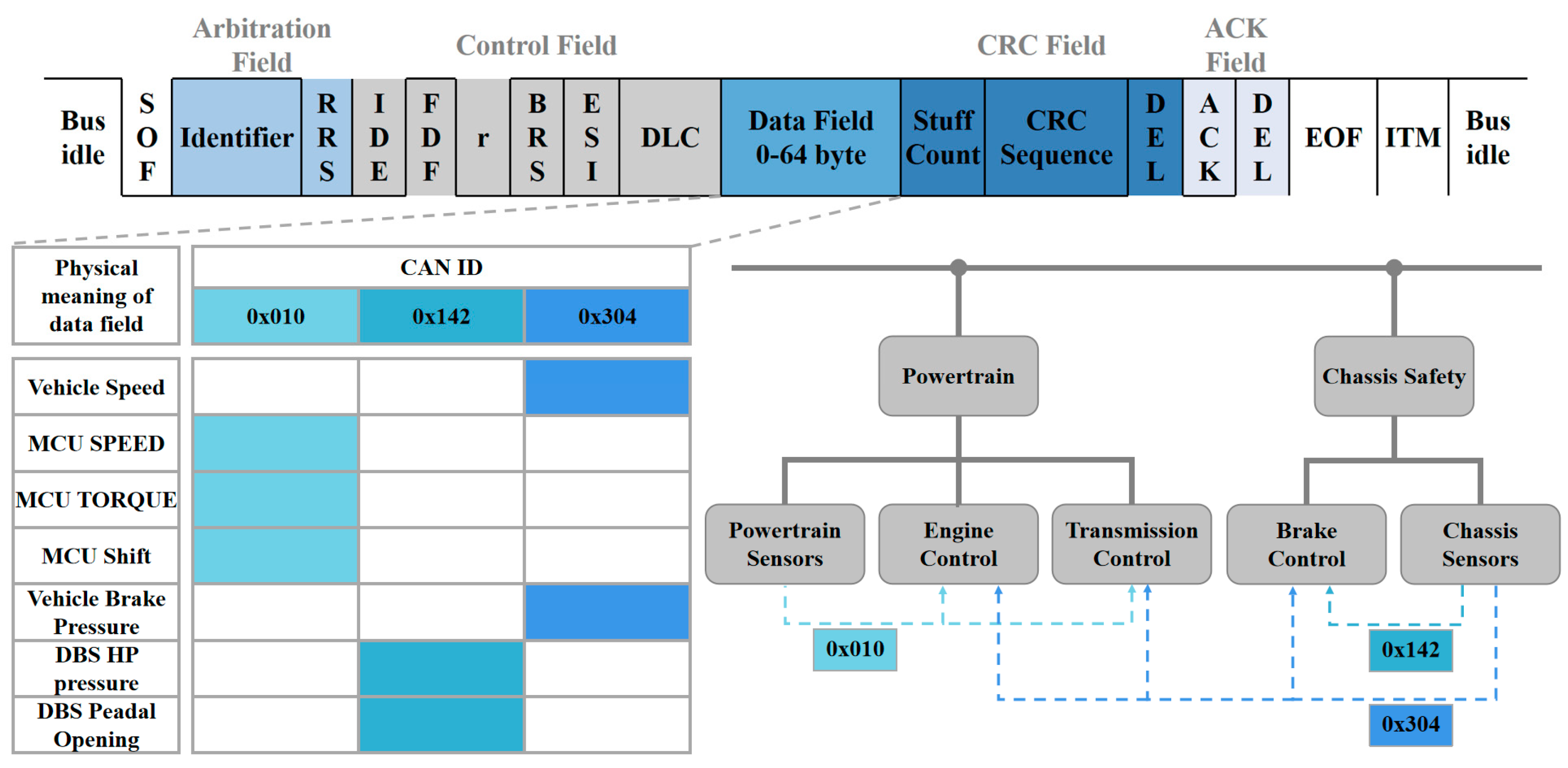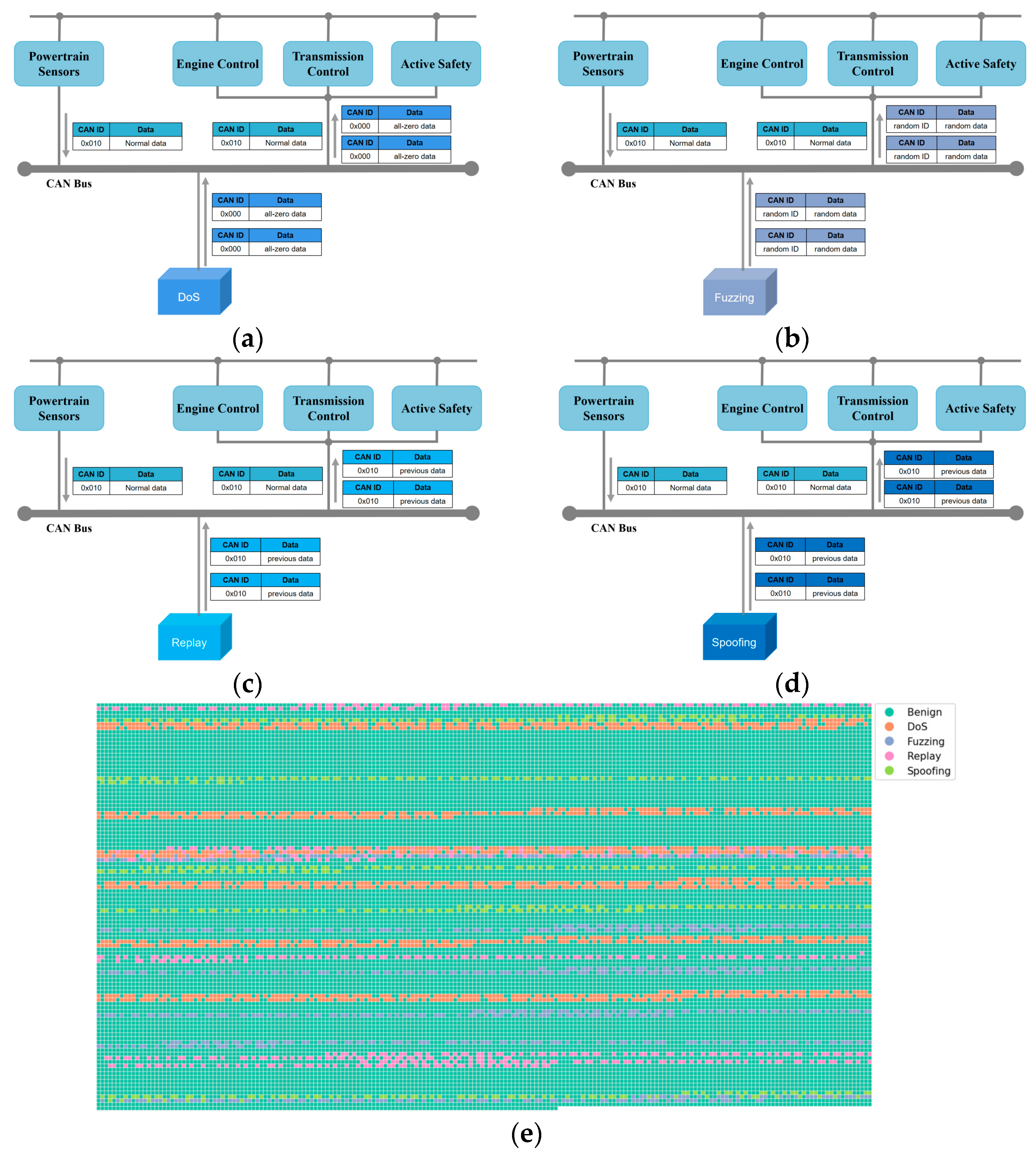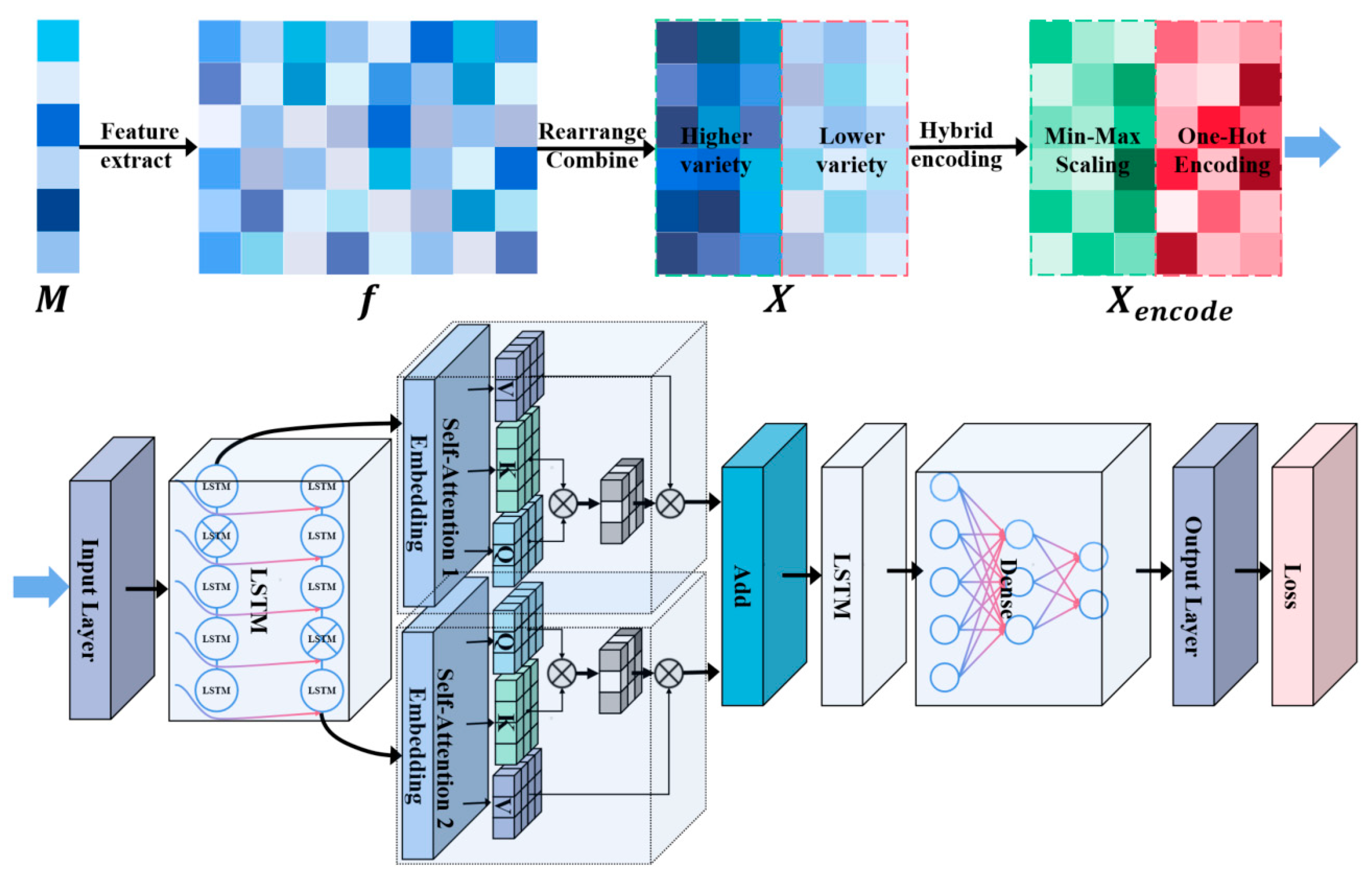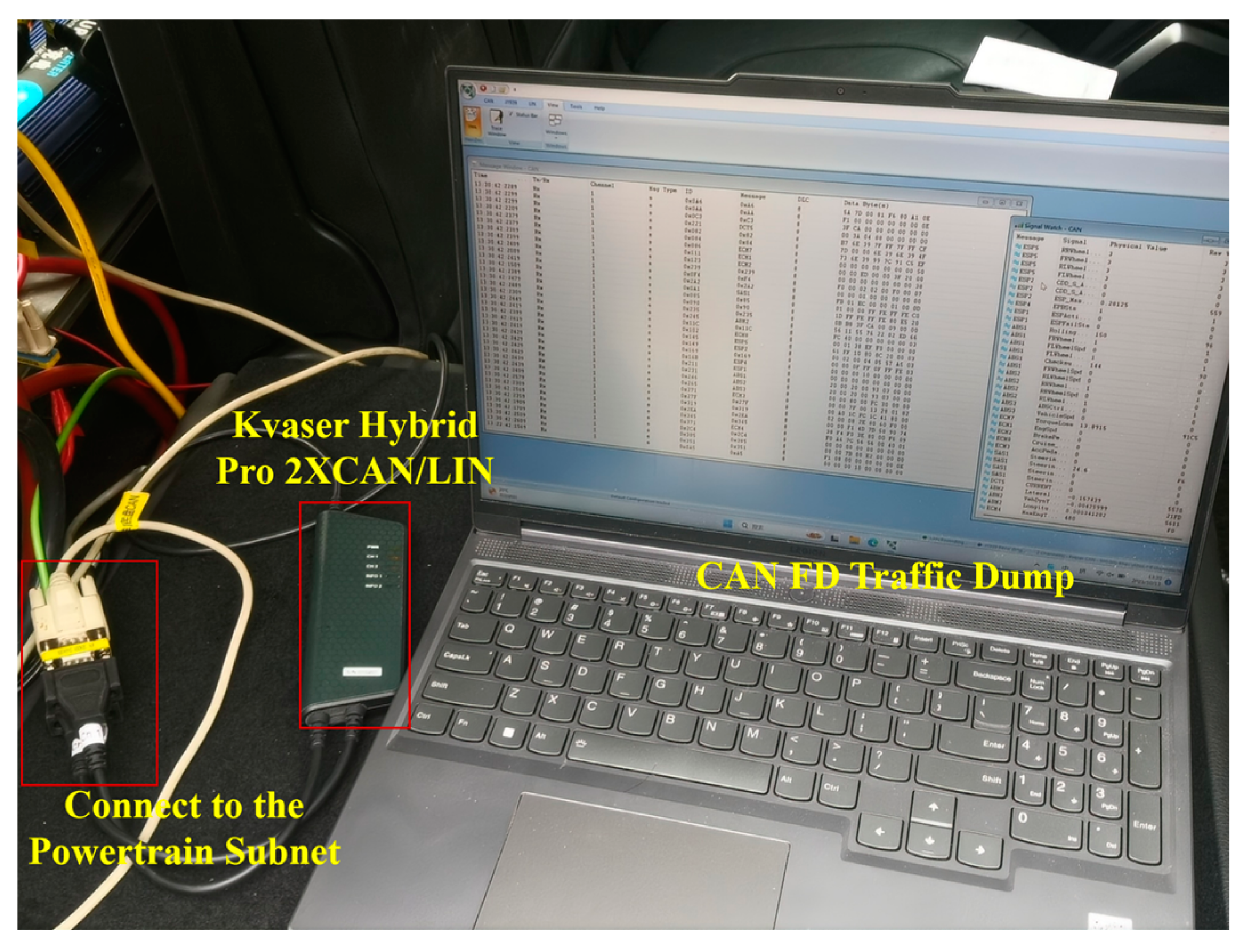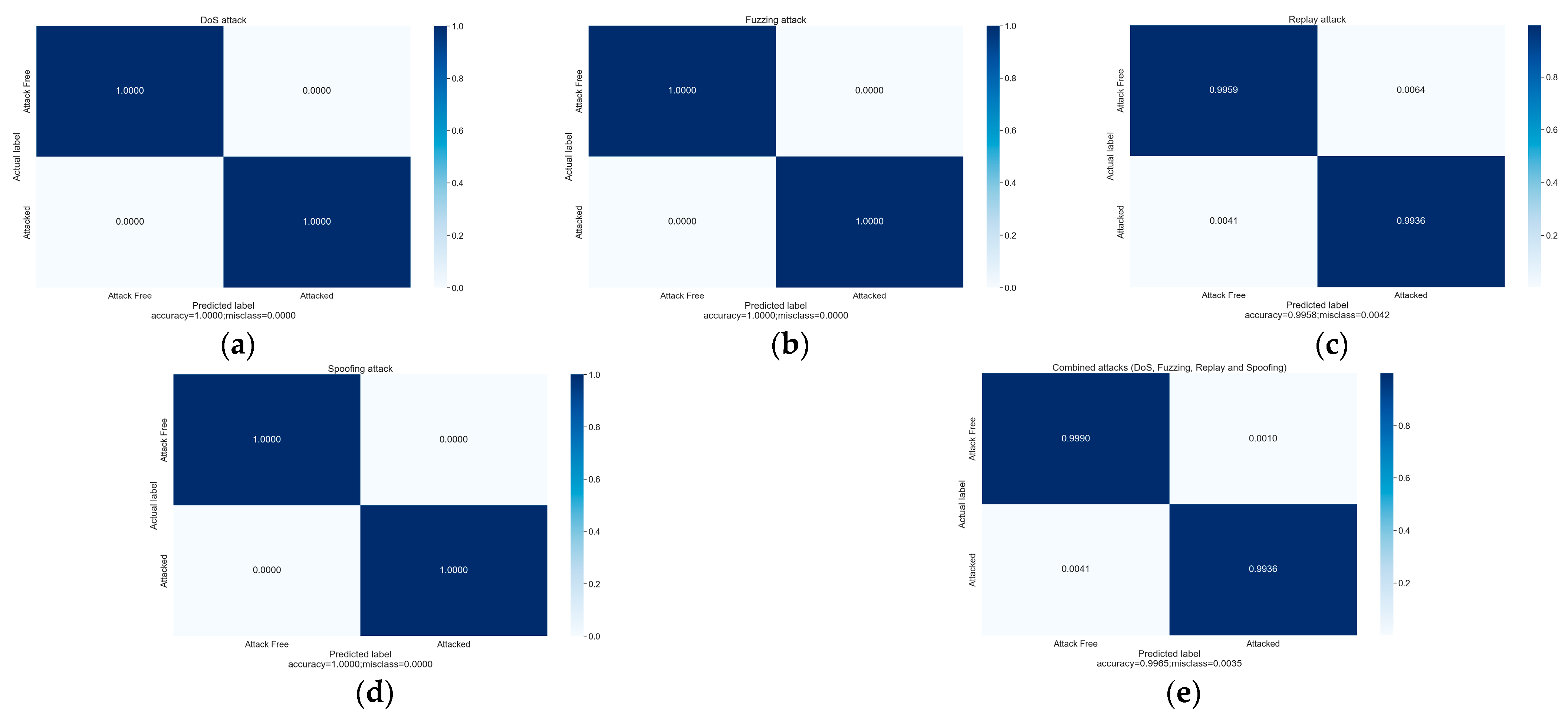1. Introduction
With the progression of information technology and the rise of the Internet of Things (IoT), intelligent connected vehicles (ICVs) have emerged as the forefront of automobile evolution. ICVs represent a next-generation breed of vehicles, outfitted with cutting-edge chips and sensors, seamlessly integrated with the Internet, and endowed with sophisticated environmental perception and advanced intelligent control systems. As vehicle interfaces proliferate and the frequency of information exchange between automotive systems and the external environment intensifies, the vulnerability of the automobile network to hacker intrusions significantly escalates. The in-vehicle Controller Area Network with Flexible Data-Rate (CAN-FD) network plays a pivotal role in facilitating real-time data exchange among multiple sensors, actuators, and ECUs situated within critical subsystems. This network is responsible for transmitting crucial physical information, such as vehicle speed, brake pressure, and the operational status of each subsystem. Vehicle manufacturers segment this data into distinct fields within the CAN-FD payload in accordance with application layer requirements. Consequently, a single CAN-FD data frame can encapsulate multiple physical attributes.
Potential security vulnerabilities in ICVs enable attackers to breach the CAN-FD network, gaining access to essential ECUs for the purpose of reading and writing through external interfaces, including physical connections (e.g., OBD II and cellular interfaces), short-range wireless connections (e.g., Bluetooth and Wi-Fi), and long-range wireless connections (e.g., over-the-air updates and GPS), as illustrated in
Figure 1. Such compromise could impact specific services within the vehicle, such as the powertrain and body/chassis server. Given that CAN-FD messages encapsulate a substantial amount of information with tangible physical significance, this information is integral for actuator control. Moreover, due to the absence of robust security mechanisms, CAN-FD networks remain susceptible to a range of attacks, including denial-of-service (DoS) attacks [
1], fuzzing attacks [
2,
3], replay attacks [
4,
5], and spoofing attacks [
6]. These attacks involve injecting attack messages to manipulate their authentic physical meaning. In
Figure 1, the first 16 bits of the message with ID 0x304 have been tampered with. Its physical meaning is linked to the speed of the vehicle and, in accordance with the communication matrix definition, can be translated into a speed signal value. The last frame with ID 0x304 in the message corresponds to a vehicle speed of 5.76 m/s. However, the tampered message now corresponds to a vehicle speed of 22.76 m/s, introducing a potential risk of loss of speed control and posing a grave threat to vehicle safety. To ensure the stability and safety of vehicle operations, it is imperative to detect anomalies within the CAN-FD network, particularly focusing on any irregularities in the physical characteristics associated with each field in the CAN-FD message. This aspect is fundamental to maintaining the normal functionality of vehicle operations.
Numerous studies have applied cryptographic algorithms, such as digital signatures, encryption, and message authentication codes, to improve message security in both CAN-FD and its foundational version, CAN. Farag [
7] employs synchronized key generators across all nodes to dynamically alter the symmetric key, facilitating the encryption of the 8-byte payload data of a CAN message. This algorithm ensures the uniqueness of the encrypted message at any given time, rendering it effective in preventing replay attacks. Jo et al. [
8] propose the MAuth-CAN authentication protocol to counter masquerade attacks on the CAN bus. Xie et al. [
9] enhance security by incorporating message authentication codes into CAN-FD messages, achieved by promptly discarding most sequences to establish a lower bound for the on-board application and employing a generous interval from the lower bound to the deadline. Subsequently, they introduced the two-pointer moving rule to dynamically adjust the message authentication code size of each CAN-FD message, ensuring real-time performance [
10]. However, the communication overhead associated with these techniques is generally high, posing challenges for their deployment in demanding real-time CAN bus networks.
In recent years, numerous intrusion detection algorithms have been proposed for CAN buses, categorized into periodicity-based and data-domain-based methods based on their detection scope and foundation. Periodicity-based methods leverage the regularity of CAN messages to identify potential anomalous behaviors within the CAN bus. Electronic Control Units (ECUs) typically generate CAN messages at specific frequencies, and deviations in message transmission frequency [
11,
12] or arrival interval time [
13,
14] can signal potential anomalies introduced by external attackers injecting messages. Normal, attack-free CAN messages exhibit standard or stable entropy, leading some researchers to propose entropy-based methods for anomaly detection in CAN [
15,
16]. External attacks on the CAN bus can induce abnormal changes in the physical attributes of the ECU, prompting the utilization of clock drift [
17,
18], clock skew [
19], or voltage [
20,
21,
22] of the ECU for anomaly detection. Olufowobi et al. [
23] detect anomalies in the network based on the real-time schedulable response time of the CAN bus, while Marchetti et al. [
24] construct transformation matrices using a standard CAN dataset, comparing sequences of attacked CAN message IDs to detect attacks. Yu et al. [
25] establish and validate the network topology through simple random wandering-based network topology to identify external intrusion devices. Despite their effectiveness in determining the normality of message periodic properties, the aforementioned periodicity-based methods cannot identify anomalies within the data domain of the message.
Data-field-based anomaly detection methods identify anomalies by predicting the data fields of the message. Wang et al. [
26] introduce an anomaly detection method based on hierarchical temporal memory (HTM) learning, wherein pre-decoded binary data streams are input into individual data sequence predictors. The output predictions are subsequently processed by an anomaly scoring mechanism. Taylor et al. [
27] employ an LSTM network on CAN message data fields for prediction, utilizing prediction errors as signals for anomaly detection in the sequence. Dong et al. [
28] construct a multi-observation Hidden Markov Model (HMM) based on the ID and data fields of normal CAN bus traffic. This model calculates the probability of frame existence within a defined time window and identifies anomalies based on whether the probability exceeds a threshold value. Zhang et al. [
29] develop the CAN message graph, integrating statistical message sequences with message contents to construct and train Graph Neural Networks (GNNs) suitable for directed attribute graphs to predict intrusions. However, the aforementioned data-domain-based anomaly detection methods typically rely on the entire frame or individual bytes within the frame as the detection unit, resulting in a coarser detection granularity or potential segmentation of the complete physical meaning of the application. This may impede the machine’s ability to effectively learn and comprehend relevant physical features, posing challenges to improving detection accuracy.
CAN-FD presents clear advantages over CAN, including elevated data transfer rates, expanded data frames, and flexible data rates, positioning CAN-FD as a gradual replacement for conventional CAN. Current anomaly detection endeavors have concentrated on traditional CAN, with minimal consideration directed towards CAN-FD. The increased size of data frames implies that CAN-FD harbors greater physical meaning within its data fields. Given that each distinct physical meaning exhibits a unique pattern of variation, approaching the comprehensive data frame as a singular unit for detection poses a challenge in precisely delineating the normal and abnormal characteristics inherent in this heterogeneous application data. To enhance the precision and granularity of anomaly discrimination in CAN-FD networks, a shift from the data link layer to a higher network application layer is essential. Fine-grained detection for each application’s physical field within the CAN-FD data frame becomes necessary to accurately identify anomalies in the genuine physical meaning of each key feature. As a result, a Physical Semantics-Enhanced Anomaly Detection (PSEAD) method for CAN-FD data fields is proposed.
The contributions of this paper can be summarized as follows:
Utilizing distinct physical meaning extraction rules for various ID messages, this approach extracts the genuine physical meaning features present in the data fields of CAN-FD messages. This enables the model to effectively identify abnormal variations in the vehicle’s key physical parameters. Additionally, based on the number of data types, the features associated with different CAN-FD IDs are reorganized and consolidated. The rearranged features undergo one-hot encoding and minimum-maximum scaling, significantly mitigating the dimensionality expansion introduced by one-hot encoding while preserving the numerical relationships intrinsic to the physical meanings.
A novel CAN-FD timing prediction model, Multiple self-attention mechanisms for time-series prediction, which combines the multi-head self-attention mechanism with an LSTM network, is introduced. This model is well-suited for forecasting the physical meaning of CAN-FD messages, offering lower computational overhead and excellent real-time performance. By incorporating the multi-head self-attention mechanism, the model adeptly directs its attention to various segments within the input sequence, facilitating the acquisition of temporal feature representations across distinct hierarchical levels and granularities. This architectural choice empowers the model to holistically capture sequence information, thereby enhancing the precision of abnormal traffic detection within CAN-FD networks.
Differing from data sources generated in simulated environments, our approach for the first time employs a dataset collected from an actual vehicle, utilizing a genuine communication protocol matrix to parse the physical meanings in CAN-FD messages. Meanwhile, attack datasets were curated by considering the mechanisms and distinctive characteristics of various attack methods. The experimental outcomes demonstrate that our method attains an accuracy improvement exceeding 4% when compared with the non-physical content-aware whole-frame combination detection method.
The remainder of this paper is structured as follows:
Section 2 provides an overview of the CAN-FD message data frame composition, in-vehicle network architecture, various types of attacks, and problem definitions;
Section 3 outlines the data preprocessing methods and delineates the construction of the attack dataset;
Section 4 delves into the intricate design particulars of the constructed multiple self-attention mechanisms for the time-series prediction model;
Section 5 focuses on the performance evaluation of the anomaly detection model; and, finally, the paper draws its conclusions in
Section 6.
6. Conclusions
In this paper, an anomaly detection method for CAN-FD networks is proposed, with a focus on ascertaining the presence of abnormal network traffic by analyzing temporal changes in the genuine physical semantics within message data fields. The method commences by initially gathering CAN-FD datasets obtained from real vehicles devoid of any cyberattacks. These datasets are subsequently partitioned into a training set and a test set. The training set is further enriched through the adjustment of the sliding window step size and the introduction of sequence order disruptions. Simultaneously, the attack dataset is formulated by infusing distinct categories of attack messages into the test set, each with varying frequencies based on their specific attack attributes. Genuine physical semantic features within the message data fields are extracted and subsequently subjected to preprocessing, encompassing tasks such as padding, reordering, normalization, and consolidation. Following this, a hybrid coding methodology is applied to effectively mitigate the dimensionality inflation that typically arises from one-hot encoding. The multiple self-attention mechanisms for time-series prediction model architecture integrates the LSTM network and incorporates a multi-head self-attention mechanism to capture temporal features in the training set. The model’s hyperparameters are meticulously fine-tuned to optimize its performance. The model’s performance is then validated using the attack dataset, and its performance under varying input features is assessed. The results reveal a substantial enhancement in anomaly detection accuracy, approximately 4–5%, when utilizing the genuine physical semantics of message data fields as inputs, compared to the utilization of byte features at the data link layer level. The proposed method proves highly effective in detecting various attack types, including DoS, fuzzing, replay, and spoofing, achieving exceptional performance metrics with an F1 score of 0.99782 and an accuracy of 99.646%. Future research will delve into anomaly detection in vehicular networks, leveraging graph theory and the incorporation of the genuine physical semantics of messages.

